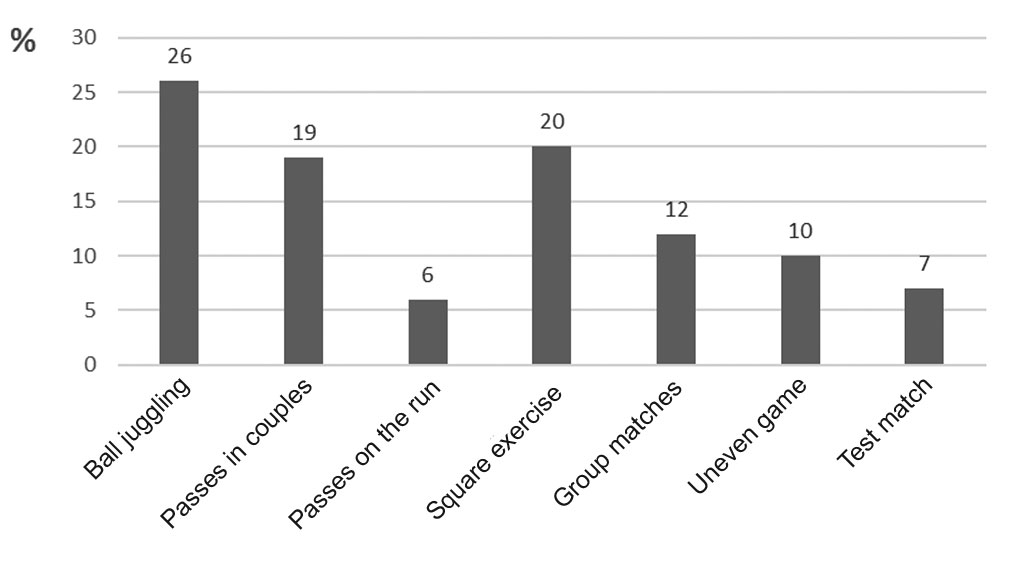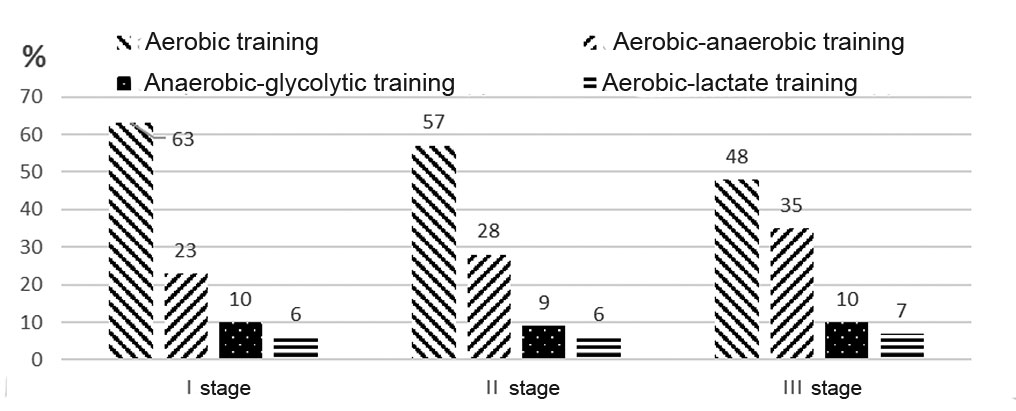Individualized preparatory staged training model for junior female footballers
ˑ:
PhD, Associate Professor D.V. Vyprikov1
PhD, Associate Professor T.N. Shutova1
I.M. Bodrov1
S.P. Golubnichiy1
1Plekhanov Russian University of Economics, Moscow
Keywords: futsal, preparatory training, combined progress tests, unspecific and specific training components, 12-14 year old female football players.
Background. The valid Women Football Development Program-2020 estimates the national football-playing women population at 30 thousand on the whole including 11 thousand formally registered by the national club system – with 200 professional club players. On the whole the Russian Women Football League incorporates 80 clubs – that means, as reported by the Russian Football Union, that the women footballing population should grow 4-5 times by 2020 [5]. It should be mentioned, however, that the futsal skills training process shall be duly customized to the individual needs, skills and qualities of the young women and, hence, requires the background and competitive fitness and training progress being tested on a reasonably objective basis versus their individual technical/ technical progress and adaptation process test data [2-5]. Still problematic at this juncture are many issues of the combined test system efficiency and the training process intensity and volume versus their cumulative benefits [1, 2]. The 12-14 year-old women footballers’ training systems have not been comprehensively addressed as yet by the theoretical and practical studies, and the situation is further aggravated by the shortage of modern digital technical skills testing tools. As a result, the women futsal training systems are still not efficient and effective enough [1].
Objective of the study was to develop and test benefits of an individualized specific and unspecific conditioning, special preparatory and precompetitive training model for junior female football players.
Methods and structure of the study. Sampled for the model testing experiment were the 12-14 year old players (n=40) from Snezhana-Kotelniki Football Club split up into Experimental and Reference Groups of 20 people each; with the Reference Group trained in the standard system and Experimental Group trained as required by the new individualized staged training model. The training process was designed on an individualized physical training-stage-specific basis. The individual progress was tested by the following tests: many pass options with the error rates; ball repossessions; ball interceptions; dribbling attempts; ball control times; and head strikes on goal [2].
The study data and analyzes were used to develop the individualized conditioning, special preparatory and precompetitive training model (see Figure 2) with the relevant specific and unspecific training tools: see Figure 1 and Table 1. The training model gives a special priority to the individual attack/ defense skills for effective competitive encounters; and the opposed/ unopposed teamwork attack/ defense techniques and tactics mastered in groups of 3 players.

Figure 1. Special training tools for junior female footballers
It should be mentioned that the pre-season trainings take around 43 days on average with once-a-day sessions that, as we believe, not efficient enough, particularly at the pre-season stage when the intensity should be lifted to two times a day. The square exercise (see Figure 1) requires the ball being controlled within some square or rectangular (with no goalposts) for the individual/ group techniques and tactics excelling purposes and for special physical progress.
Table 1. Unspecific training tools
|
|
Training tools |
Execution |
Site size, distance, time |
HRmin-mах, bpm |
|
1 |
No-rush run, bosu run |
Cross-country interval 3min racing, 4-5 times |
1.8-6km, 3min intervals |
136-150 130-146 |
|
2 |
Speed-ups |
10х40m |
400m |
168-179 |
|
3 |
Sprint |
5х30m with 90s rest breaks 10х100m with 100s rest breaks 10х60m with 90s rest breaks 10х30m with 90s rest breaks |
150m 250m 1000m 600m 300m |
133-150 181-199 155-167 145-173 139-165 |
|
4 |
Rope jumps, elementary aerobic practices |
5х100 times with musical illustrations |
500 jumps per 10min |
178-193 135-145 |
|
5 |
Hurdles |
10 runs of 10 hurdles each with 100s rest breaks |
100 jumps |
167-175 |
|
6 |
Stretching gymnastics |
Lifted leans; bridges; splits etc. |
10min |
123-132 |
|
7 |
Individual exercises |
Speed-strength, coordination, techniques, tactics and game-role-specific ones |
15min |
136-148 |
The unspecific training tools offered by the model included the rope jumps; upstairs run; no-rush cross-country race; bosu run; elementary aerobics; and the game-role-specific skills excellence tools: see Table 1. The new model was tested with the following shares of the unspecific and specific training tools (respectively): 75% and 25% for the conditioning stage; 80% and 20% for the special preparatory stage; and 86% and 14% for the pre-season stage.

Figure 2. Preparatory training process components for skilled female footballers: I conditioning stage; II special preparatory stage; III pre-season stage
The group trainings in the pre-season period were dominated by the even and uneven training methods taking 43% and 32% of time, respectively; followed by the repeated and interval-serial trainings (9% and 15%, respectively. The interval-serial trainings were found particularly beneficial for the speed-endurance and speed-strength exceling purposes. The special preparatory and precompetitive training stages were designed to scale down the anaerobic-glycolytic and aerobic-lactate training tools as these qualities are claimed by competitions: see Figure 2.
Results and discussion. The experimental individualized specific and unspecific conditioning, special preparatory and pre-season training model was tested beneficial as verified by the EG versus RG meaningful progress in the following aspects: ball control with the error rate of 10% (see Table 2); techniques/ tactics versatility, as the actions grew from 540 to 623 with the technical errors estimated to fall from 38% to 27% to come close to the standard. The progress was facilitated, as we believe, by the individualized training tools including the bosu practices, elementary aerobics and game-role-specific ones. Dribbling success rate was estimated to grow from 28 to 45 due to progress in the actively opposed techniques and tactics. The strike-on-goal error rate sagged from 61% to 37%, with the strikes per match estimated to grow from 34 to 51 to near the desired model level. The square exercise and progress in the individual attack skills has improved the passing accuracy, with the long passes found to fall from 16 to 14 and the short-to-middle-distance forward passes to grow from 131 to 157 per match: see Table 2.
Table 2. Game techniques and tactics by years of the model testing experiment
|
|
Techniques and tactics |
Year 1 |
Year 2 |
Meaning, р |
|||
|
Count |
Error rate, % |
Count |
Error rate, % |
Ι-ІІІ |
ІІ-ΙV |
||
|
1 |
Short- to-middle-distance forward passes |
131±8,1 |
32±2,7 |
157±9,2 |
26±3,1 |
<0,05 |
<0,05 |
|
2 |
Short- to-middle-distance back/ cross passes |
148±11,8 |
11±1,0 |
165±10,7 |
9±1,1 |
<0,05 |
<0,05 |
|
3 |
Long passes |
16±2,7 |
44±1,4 |
14±3,1 |
42±1,4 |
>0,05 |
<0,05 |
|
4 |
Ball control, s |
75±6,7 |
12±0,7 |
81±3,2 |
10±1,1 |
>0,05 |
<0,05 |
|
5 |
Dribbling |
28±2,4 |
29±2,7 |
45±3,1 |
22±1,8 |
<0,05 |
<0,05 |
|
6 |
Repossession |
60±5,4 |
39±1,7 |
65±4,3 |
27±2,5 |
>0,05 |
<0,05 |
|
7 |
Interception |
43±4,1 |
31±1,7 |
40±3,5 |
24±1,5 |
>0,05 |
<0,05 |
|
8 |
Head strikes |
5±0,8 |
40±2,7 |
3±0,8 |
42±2,5 |
>0,05 |
>0,05 |
|
9 |
Head strikes on goal |
3 ± 0,7 |
33±2,4 |
4 ± 1,8 |
31±2,1 |
>0,05 |
>0,05 |
|
10 |
Foot strikes on goal |
34±2,4 |
61±3,0 |
51±3,1 |
37±2,1 |
<0,05 |
<0,05 |
|
Total per match |
540±17,1 |
37±3,7 |
623±12,1 |
28±1,8 |
<0,05 |
<0,05 |
|
Physical fitness of the sample was rated by the following tests: (1) 10-15-20m speed-up/ rush; (2) 30-60-100m sprint (key element of the game); (3) 4х12/ 7х50m shuttle sprint (to rate the special endurance and movement coordination); (4) standing long jump; up-and-down the 30-40-50cm platform jumps; standing high jumps; and the squats tests (to rate the speed-strength and explosive leg strength qualities).
Conclusion. The new individualized conditioning, special preparatory and pre-season training model with its balanced efficient specific and unspecific training tools was tested beneficial as verified by the significant progress of the EG versus RG with drops in the technical error rates and growth in the game techniques and tactics success rates.
References
- Averyasova Yu.O., Filimonova S.I., Andryushchenko L.B. et al. Optimizatsiya podgotovki sportivnogo rezerva v basketbole na etape vysshego sportivnogo masterstva [Sport reserve training system optimization in elite basketball]. Teoriya i praktika fiz. kultury, 2018, no. 6, pp. 79-80.
- Vyprikov D.V. Uchebno-trenirovochny protsess kvalifitsirovannykh sportsmenok v mini-futbole [Training process of skilled futsal players]. Moscow: Plekhanov RUE publ., 2017, 80 p.
- Satalkina T.V., Kozlova S.Yu. Osobennosti sportivnoy podgotovki zhenskoy studencheskoy komandy po mini-futbolu [Features of athletic training of women's futsal team]. Fizicheskaya kultura, sport i zdorovye, MSU, Yoshkar-Ola, 2018, no. 31, pp. 130-134.
- Fedchuk D.V., Fedchuk V.V. Soderzhanie sportivnoy podgotovki zhenskoy komandy po mini-futbolu [Contents of athletic training of women's futsal team]. Nauka i obrazovanie v XXI veke [Science and Education in the XXI century]. International res.-pract. conference, Lyubertsy, 2015, pp. 60-62.
- Chernysheva E.N., Primak I.S., Smirnova S.A., Pryanishnikova O.A. Innovatsionny podkhod v modelirovanii dvigatelnoy podgotovki zhenskikh komand po mini-futbolu [Innovative approach in simulation of motor training of women's futsal teams]. Teoriya i praktika fiz. kultury, 2015, no. 6, pp. 51-54.
Corresponding author: drevobrad@mail.ru
Abstract
The study was intended to develop and test benefits of an individualized conditioning, special preparatory and pre-season training model for junior women football players. The model combines specific and unspecific training tools applicable in the preparatory training periods. Sampled for the model testing experiment were the 12-14 year old players (n=40) from Snezhana-Kotelniki Football Club split up into Experimental and Reference Groups of 20 people each; with the Reference Group trained in the standard system and Experimental Group trained as required by the new individualized staged training model. The training process was designed on an individualized physical training-stage-specific basis. The individual progress was tested by the following tests: different pass options with the error rates; ball repossessions; dribbling attempts; ball control times; and the head strikes on goal. The new model was tested particularly beneficial with the following shares of the unspecific and specific training components (respectively): 75% and 25% for the conditioning stage; 80% and 20% for the special preparatory stage; and 86% and 14% for the pre-season stage.

